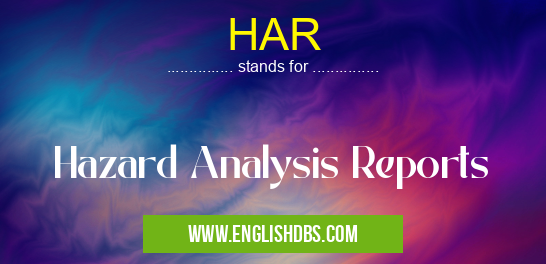What does HAR mean in UNCLASSIFIED
Hazard Analysis Reports (HARs) are comprehensive documents that outline potential hazards associated with a specific activity or process. They include measures to mitigate or eliminate these hazards, ensuring the safety of individuals involved and the integrity of the system.

HAR meaning in Unclassified in Miscellaneous
HAR mostly used in an acronym Unclassified in Category Miscellaneous that means Hazard Analysis Reports
Shorthand: HAR,
Full Form: Hazard Analysis Reports
For more information of "Hazard Analysis Reports", see the section below.
Importance of HARs
HARs play a crucial role in risk management by:
- Identifying potential hazards that may arise during an operation or activity
- Assessing the severity and likelihood of these hazards occurring
- Developing and implementing control measures to minimize the risks associated with each hazard
- Providing a systematic approach to hazard management, ensuring thorough consideration of all potential hazards
Contents of a HAR
HARs typically include the following sections:
- Hazard Identification: A list of all potential hazards identified
- Hazard Assessment: An evaluation of the severity and likelihood of each hazard
- Control Measures: Specific actions or procedures implemented to mitigate or eliminate each hazard
- Monitoring and Evaluation: A plan for regularly reviewing the effectiveness of control measures and making adjustments as necessary
Essential Questions and Answers on Hazard Analysis Reports in "MISCELLANEOUS»UNFILED"
What are Hazard Analysis Reports (HARs)?
HARs are systematic assessments that identify potential hazards and their associated risks within a specific operation or process. They provide valuable insights into potential safety and health concerns, enabling organizations to implement appropriate control measures to mitigate these risks.
Why are HARs important?
HARs play a crucial role in preventing accidents, minimizing risks, and ensuring the safety and health of individuals involved in an operation or process. By proactively identifying and addressing potential hazards, organizations can establish a safer work environment and reduce the likelihood of incidents.
How are HARs conducted?
HARs typically involve a team of experts who conduct a thorough investigation of an operation or process. The team uses a structured approach to identify potential hazards, assess their severity and likelihood, and recommend appropriate control measures. The investigation may involve observations, interviews with personnel, and a review of relevant documents.
What are the benefits of using HARs?
HARs offer numerous benefits, including:
- Identifying and mitigating potential hazards, thereby preventing accidents and injuries.
- Complying with regulatory requirements related to safety and health.
- Improving the overall safety culture within an organization.
- Reducing operational costs associated with incidents and accidents.
How can I ensure the quality of my HARs?
To ensure the quality of HARs, it is essential to follow best practices, such as:
- Involving a multidisciplinary team with expertise in the relevant field.
- Using a structured and standardized approach to identify and assess hazards.
- Documenting all findings and recommendations clearly and concisely.
- Regularly reviewing and updating HARs to reflect changes in the operation or process.
Final Words: HARs are essential tools for ensuring safety and managing risks in various industries and operations. They provide a structured approach to identifying and controlling hazards, minimizing the likelihood and impact of incidents. By adhering to HARs, organizations can create a safer work environment and protect their assets.
